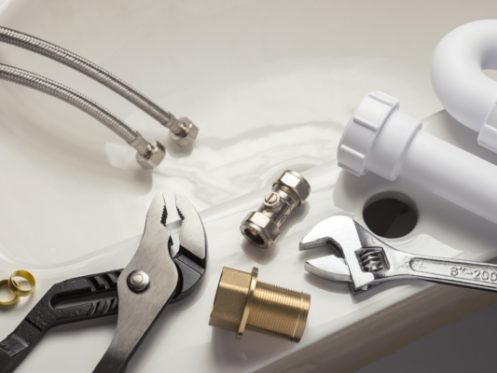Eco-friendly plumbing is an important way to reduce your footprint on the earth. According to the Environmental Protection Agency (EPA), the average household of four people can use up to 10,000 gallons of water in a month. Even if you try to use less water, outdated or inefficient plumbing can cause unintentional waste.
Fortunately, there are environmentally friendly solutions that promote sustainability within your home. A look at some of the best plumbing ideas can help you do your part in conserving our planet’s resources for future generations.
Install Low-Flow Faucets and Filters
One of the simplest ways to create an eco-friendly home is to install low-flow showerheads, faucets, and other fixtures that reduce water waste. Low-flow faucets work by limiting the amount of water that can pass through a fixture at once. These low-flow devices may use innovative technologies, including aerators, pressure regulators, or flow restrictors. These technologies help keep water pressure consistent while lowering the overall output.
For example, while conventional showerheads pump up to 2.5 gallons of water per minute, low-flow showerheads use fewer than two gallons in the same time frame. This means that instead of using over 25 gallons of water over the course of a 10-minute shower with a traditional showerhead, you can reduce water usage to well under 20 gallons without sacrificing shower quality.
Similarly, consider getting a motion-sensor sink faucet that activates only when your hand moves under it. This can reduce water consumption by automatically turning the water off while brushing your teeth or washing your hands. It is a great way to help conserve water resources, and experts highly recommend this method for people living in areas known for water scarcity.
By using less water, you may also find that low-flow faucets help lower your monthly water bill. Additionally, using less water may mean that your water heater spends less time warming things up, potentially reducing your energy bill.
Choose a Tankless Water Heater
Tankless water heaters are energy-efficient models designed to provide hot water only as needed. Whereas a conventional water heater constantly keeps warm water stored in a reservoir, a tankless water heater only heats water on demand. This energy-efficient system pushes water through a heating unit and out of the faucet instead of letting it sit in a holding tank for hours.
Tankless water heaters have several potential advantages. First, this type of heater can reduce energy consumption because there is no need to constantly heat a water tank. Lower energy consumption will result in a lower utility bill.
Next, tankless water heaters are ideal for supplying continuous hot water to large households and businesses. Traditional plumbing systems run out of hot water when the tank empties, requiring you to wait for it to refill and heat up again. In contrast, a tankless system heats water on the spot so there is always hot water for cooking, cleaning, or showering. Finally, tankless systems are more compact and use less space than conventional heaters.
Upgrade to Water-Efficient Toilets
Toilets made before 1980 require five to seven gallons of water per flush. In contrast, high-efficiency toilets use as little as 1.28 gallons of water to complete the job.
Most water-efficient toilets use either a dual-flush process or a pressure-assisted system. Dual-flush systems have two buttons that enable users to choose between a low-flow flush for liquid waste or a high-flow flush for solid waste. Pressure-assisted toilets use compression technology to push water through the pipes. This dynamic motion uses a lot less water than traditional toilets. A certified plumber can help you select the best option for your household needs.
You can enjoy several advantages when you install a water-efficient toilet. Foremost, these toilets can significantly reduce water consumption throughout the day. Less usage will lower your utility bill and help conserve local water resources. Also, low-flow toilets are usually much more compact, saving space in your bathroom. Overall, water-efficient toilets are among the best ways to modernize your bathroom and home.
Prep Your Hot Water Pipes
Another way to create an eco-friendly home is to prep your water pipes. The first step is to consider insulating your water pipes. Conventional water pipes can require you to leave the tap running as you wait for the hot water to reach it. If your pipes have poor insulation, hot water can lose heat even faster as it travels to different parts of your home. Hiring a professional to properly insulate your pipes ensures that hot water maintains the right temperature as it flows from the heater to your bathroom or kitchen.
If it is time to replace your water pipes completely, you can also consider eco-friendly materials. Two environmentally friendly choices for pipes are copper and stainless steel. Nearly half of the copper products in the United States derive from recycled scrap, and copper pipes remain recyclable at the end of their life span. Stainless steel pipes are also 100% recyclable and do not corrode easily, making them a viable choice for an eco-friendly household. You can request that a professional fully insulate the pipes upon installation.
Get Eco-Friendly Pipe Cleaning
Drainage pipes remove waste and ensure proper flow of water throughout your home. Due to constant usage, most drainage pipes require periodic cleaning. The frequency depends on the household’s habits. Unfortunately, many conventional cleaning products contain toxic ingredients that can contaminate the environment and damage your plumbing. For true sustainability, you can hire a professional to use eco-friendly drainage products. A trained plumber can use all-natural alternatives to unclog drains, treat septic tanks, and clear pipes so that your water system operates smoothly.
Eliminate Water Leaks
To keep your home environmentally friendly, try to get water leaks fixed as soon as you notice them. Even if a leak seems like merely a few drips here or there, this amount can add up to large quantities of water after a few hours, days, or weeks. In fact, the EPA estimates that an average household’s leaks waste approximately 10,000 gallons of water each year. You should suspect a serious leak somewhere if your household uses more than 12,000 gallons of water a month.
Other signs of leaks include water stains, damp faucets, running toilets, or unexplained trickling sounds. A reputable plumber can identify the source of the leak and make repairs. You should also consider contacting a plumber if you see a sudden rise in your home water usage or notice that the meter keeps running even after you turn off faucets within the home.
Contact Us for Effective Plumbing Solutions Today
From low-flow faucets to energy-efficient toilets, eco-friendly plumbing is a productive way to upgrade your home. If you need help with repairing or improving your water system anywhere in the Denver area, reach out to the experts at Summit Heating & A/C. Our plumbers can perform leak detection and repair, and we offer advanced services like tankless water heaters and septic treatment. Contact our team at Summit Heating & A/C as a one-stop service for all your plumbing needs.


